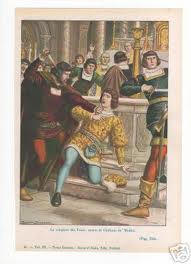Francesco de' Pazzi
Francesco de' Pazzi | |
|---|---|
 Francesco de' Pazzi stabbing Giuliano de' Medici | |
| Coat of arms |  |
| Born | 28 January 1444 Florence, Italy |
| Died | 26 April 1478 (aged 34) Florence, Italy |
| Noble family | Pazzi |
| Occupation | Banker |
Francesco de' Pazzi (28 January 1444 – 26 April 1478) was an Italian banker and one of the instigators of the Pazzi conspiracy.
On Sunday, 26 April 1478, in an incident known as the Pazzi conspiracy, a group headed by Girolamo Riario, Francesco de' Pazzi and Francesco Salviati attacked Lorenzo de' Medici and his brother, the co-ruler Giuliano, in the Duomo of Florence, Santa Maria del Fiore, in an attempt to seize control of the Florentine government.[1] Giuliano de' Medici was assassinated by Francesco de' Pazzi and Bernardo Baroncelli.[2] He was killed by a sword wound to the head and was stabbed 19 times.[3]
He, Jacopo de' Pazzi and Renato de' Pazzi were executed after the plot failed.[4]
In popular culture[]
Francesco de' Pazzi was sung by bass Ludovico Contini in the first performance of Leoncavallo's 1893 opera I Medici.[5][6]
Francesco is a villain and an assassination target in the video game Assassin's Creed II, where he is voiced by Andreas Apergis.[7] In the game, he has a son named Vieri.[8] Both characters are killed by the series protagonist Ezio Auditore da Firenze.
Elliot Levey portrayed Francesco de' Pazzi in TV series Da Vinci's Demons.[9]
Francesco is referenced in the movie Hannibal, when Hannibal Lecter meets a modern day relative, Chief Inspector Rinaldo Pazzi. Rinaldo tries to capture Hannibal as part of a large reward; however, he meets a similar fate to his predecessor: Lecter hangs and disembowels Pazzi.
Francesco appears in the second season of Medici: Masters of Florence, played by Matteo Martari.[10]
References[]
- ^ Jensen, De Lamar (1992). Renaissance Europe: Age of Recovery and Reconciliation (2nd ed.). Lexington, Massachusetts: D. C. Heath and Company. p. 80. doi:10.2307/3167078. ISBN 9780669200072. JSTOR 3167078. OCLC 25171924.
- ^ Smedley, Edward; James, Hugh James; Rose, Henry John (1845). Encyclopaedia Metropolitana; Or, Universal Dictionary of Knowledge on an Original Plan Comprising the Twofold Advantage of a Philosophical and an Alphabetical Arrangement, with Appropriate Engravings. B. Fellowes. p. 272.
- ^ Koestler-Grack, Rachel A. (1974). Joseph, Michael (ed.). Leonardo Da Vinci: Artist, Inventor, and Renaissance Man. Infobase Publishing. p. 152. ISBN 978-0791086261.
- ^ Hibbert, Christopher (6 December 2001) [1 January 1974]. The Rise and Fall of the House of Medici. Harmondsworth, Middlesex: Penguin UK. p. 141. ISBN 0140050906.
- ^ Casaglia, Gherardo (2005). "I Medici, 9 November 1893". L'Almanacco di Gherardo Casaglia (in Italian).
- ^ Farr, Robert J. (August 2010). "Review – Leoncavallo – I Medici". MusicWeb International. Retrieved 30 August 2010.
- ^ Castaño Ruiz, Clara (18 October 2015). "Assassin's Creed: 10 momentos históricos de la saga". Hobby Consolas (in Spanish). Retrieved 9 May 2018.
- ^ Makedonski, Brett (14 November 2016). "The Ezio Collection represents some of the best and the worst for Assassin's Creed". Destructoid. Retrieved 9 May 2018.
- ^ Hale, Mike (11 April 2013). "The He-Man Who Gave Mona Lisa That Smile". The New York Times. Retrieved 9 May 2018.
- ^ Spencer, Samuel (26 January 2019). "Medici family tree: How are the new characters related to season 1?". Daily Express. Retrieved 26 February 2019.
External links[]
 Media related to Francesco de' Pazzi at Wikimedia Commons
Media related to Francesco de' Pazzi at Wikimedia Commons
- 1444 births
- 1478 deaths
- Italian bankers
- People executed by Florence
- Pazzi family
- Italian murderers
- 15th-century Italian businesspeople
- People executed by hanging